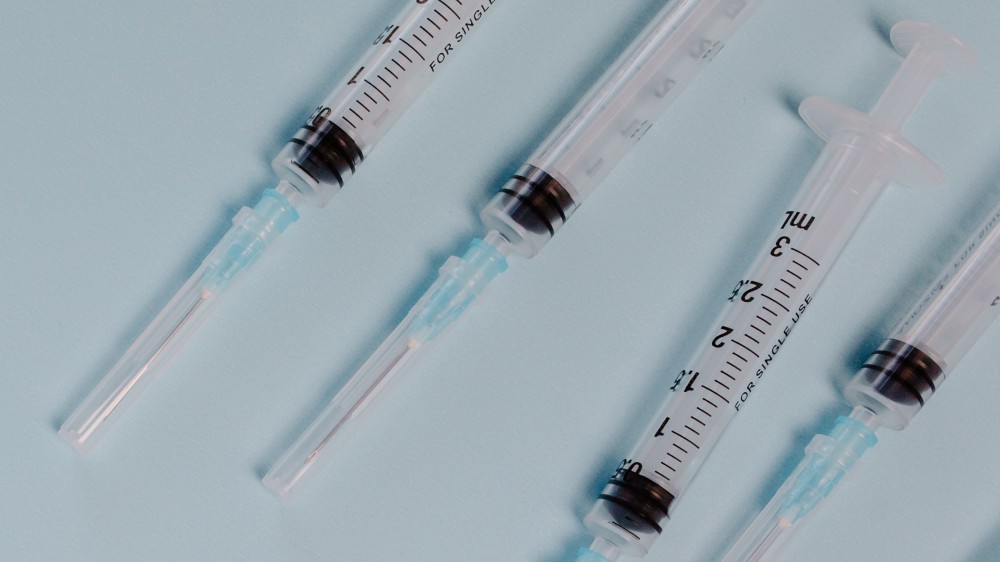Blood sampling: Dog
Non-surgical approaches for sampling blood in the dog.
General principles
Cephalic vein (non-surgical)
Technique
Dogs can be trained to sit calmly on a table for blood sampling. They will remember receiving a reward (e.g. food treat) after the procedure, which can make them easier to handle on subsequent occasions.
Blood samples can be collected from the cephalic vein which is superficial and easily accessible. The technique is quick and appropriate for taking small blood samples. Blood is collected from the forelimb, starting distally (near the paw) and working proximally (away from paw). Where multiple samples are taken, the use of the forelegs should be alternated. Appropriate aseptic technique should be used, including clipping the hair around the sampling site and cleaning with an antiseptic solution. Blood should not be taken from a vein that has been used to administer intravenous drugs.
A temporary catheter can be used for multiple samples taken over a short period of time (more than four samples from one vein in a 24-hour period). A video of how to place an intravenous catheter in the dog cepahlic vein is available from the veterinary training resource atdove.org (note appropriate PPE should be worn, such as gloves).
Dogs can either be restrained manually or using a sling. A non-slip mat can help hold the dog steady. Animals should be acclimatised to restraint and the sound of the clippers before being used in experiments.
2 - 5 ml of blood can be collected per sample and, depending on sample volume and scientific justification, normally no more than eight samples in a 24-hour period; more frequent sampling can cause the forelegs to become bruised. The number of attempts to obtain blood should be minimised to a maximum of three needle sticks for each sample. Bleeding should be stopped, before the dog is returned to its pen, by finger pressure to the sampling site for approximately 30 seconds.
Summary
| Number of samples | No more than eight blood samples (four from either leg) should be taken in any 24 hour period. |
| Sample volume | up to 2-5 ml, depending on the size of dog. |
| Equipment | 21G or wider needle |
| Staff resource | Two people are required to take the blood sample; one for restraining and raising the vein of the dog, and one for taking the blood sample. |
| Adverse effects |
|
| Other | Stress associated with the technique can be minimised by training and acclimatising the dog to restraint and the sound of the clippers beforehand. A reward (e.g. food treat) should always be provided after the procedure. |
Resources and references
- Ooms TG et al. (2004). Clinical and hematological effects of serial phlebotomy performed on laboratory beagles. Contemporary topics in Laboratory Animal Science 43(3): 38-42. PMID: 15174816
Jugular vein (non-surgical)
Technique
Dogs can be trained to sit calmly on a table for blood sampling. They will remember receiving a reward (e.g. food treat) after the procedure, which can make them easier to handle on subsequent occasions.
Sampling from the jugular vein is quick and simple as the vein is superficial and easily accessible. It is appropriate for small and large blood samples.
The dog is restrained manually. Sampling sites are alternated between the two jugular veins, starting distally at the base of the neck and moving towards the head along the jugular groove. The vein is raised by compressing it just dorsal to the thoracic inlet, ventral to the venepuncture site.
Aseptic technique should be used, including clipping the hair around the sampling site. 2 - 20 ml of blood can be taken per sample and, depending on sample volume and scientific justification, up to eight samples in a 24-hour period; more frequent sampling can cause bruising. The number of attempts to obtain blood should be minimised to a maximum of three needle sticks for each sample. Bleeding should be stopped, before the dog is returned to its pen, by applying finger pressure to the sampling site for approximately 30 seconds.
Summary
| Number of samples | No more than eight blood samples should be taken in any 24 hour period. |
| Sample volume | up to 2-20 ml, depending on the size of dog. |
| Equipment | 21G (preferably 1" long) needle |
| Staff resource | Two people are required to blood sample; one for restraining and raising the vein of the dog, and one for taking the blood sample. |
| Adverse effects |
|
| Other | Stress associated with the technique can be minimised by training and acclimatising the dogs to manual restraint and the sound of the clippers beforehand. A reward (e.g. food treat) should always be provided after the procedure. |
Resources and references
- Lucas RL et al. (2004). Collection and preparation of blood products. Clinical techniques in small animal practice 19(2): 55-62. doi: 10.1053/j.ctsap.2004.01.007
- Millis DL et al. (1995). Comparison of coagulation test results for blood samples obtained by means of direct venipuncture and through a jugular vein catheter in clinically normal dogs. Journal of the American Veterinary Medical Association 207(10): 1311-4. PMID: 7591925
You should read the general principles of blood sampling page before attempting any blood sampling procedure.

